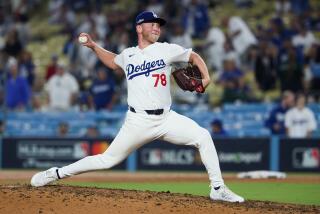Style Carries Palmer to Hall
Be it baseballs or bikini briefs, Jim Palmer always pitched with style and success.
On Sunday, his elegance and excellence will be rewarded. Palmer, along with Joe Morgan, will be inducted to the Hall of Fame.
Palmer was elected in January when he was named on 92.5 percent of the ballots -- Bob Feller, with 93.75 in 1962, was the only pitcher to get a higher percentage.
That Palmer made it to Cooperstown on his first try despite not winning 300 games is a testament to just how good he was for 20 seasons, all with the Baltimore Orioles.
Palmer won 20 games eight times from 1970-78; only five other pitchers who played exclusively in this century reached the 20-victory mark so much. His 2.86 earned run average ranks fourth all-time among pitchers with at least 3,000 innings.
Palmer was 268-152 lifetime, a .638 winning percentage. He won the Cy Young Award three times and pitched a no-hitter, on Aug. 13, 1969, against Oakland.
And, like many of the gameâs greats, Palmer came through in the clutch. He was 4-1 in the playoffs, 4-2 in the World Series.
It was during the 1966 World Series that the fresh-faced Palmer, with his high leg kick and smooth, overhand delivery, first came to national prominence. He became the youngest to pitch a shutout in the Series, tossing a four-hitter to beat Los Angeles 6-0 in Game 2.
At age 20, Palmer outdueled another future Hall of Famer, Sandy Koufax. It turned out to be Koufaxâs last appearance as Baltimore swept in four games.
Then, in 1983, it was Palmerâs turn. He was injured that season and not in the Oriolesâ starting rotation against Philadelphia in the World Series. So Palmer became a reliever, pitching two scoreless innings in Game 3 for the victory. It was his last win in the big legaues, and it sent the Orioles to their most recent championship.
In May 1984, after five bad outings, the Orioles released him at age 39. At the time of his emotional farewell, Palmer looked young enough to be successful at a young manâs game, but his fastballs were not so fast, his curves not as cutting. He believed he still could pitch, but he accepted the decision of owner Edward Bennett Williams with class.
âIf you choose to have baseball people around you and thatâs what they say, then you should listen to them,â he said.
So that was it. Unlike other aging stars such as Steve Carlton and Tommy John, Palmer did not linger and try to catch on somewhere else.
âI tore my rotator cuff when I was 20, so I was fortunate to ever pitch again,â Palmer said. âBut if I would have had the medical knowledge available now, and had not been asked to pitch into the eighth and ninth innings, which is when youâre tired and running the greatest risk of hurting your arm, I think I could have pitched for 25 years.â
Fortunately for him, Palmer did not need to wear a uniform to be a winner. In fact, he didnât have to wear much of anything at all.
Palmer became the poster pinup for underwear in 1980. Polished as poser, his good looks made the endorsements a lucrative and long-term venture for him and the company he represented.
Palmer, showing the same smarts that helped him on the mound, began another career during his playing days. He worked 13 years as an analyst for ABC-TV in the postseason and then joined the Oriolesâ television team last year. Heâs now in his second season and has made the difficult transition to play-by-play man with ease.
Palmerâs election made him and Brooks Robinson the second pair of Hall of Fame broadcasting partners -- Al Kaline and George Kell share the Detroit Tigersâ duties.
As an announcer, Palmer is cool, calm and collected. He was that way as a player, too, except when it came to dealing with manager Earl Weaver.
The excitable Weaver often accused Palmer of thinking too much, and maybe it was so. But the results could not be argued; Orioles prospered because of both of them.
âI remember before the first game of the 1970 World Series, we were going over the hitters. Bobby Tolan, fastball hitter. Pete Rose, fastball hitter. Lee May, fastball hitter. Johnny Bench, fastball hitter. Tony Perez, fastball hitter. ... We went right down the entire Cincinnati Reds lineup,â Palmer recalled. âAfter about seven fastball hitters, I raised my hand and said, âWhy am I pitching?â Earl said, âBecause theyâre not going to hit your high fastball.ââ
Palmer, true to form, knew how to stay out of trouble. In 3,948 innings in the major leagues, he never gave up a grand slam.
But that didnât hold in the minors. In 1967, Palmer was back at Class AAA Rochester, trying to overcome arm problems that threatened to end his career.
The story goes that the bases were loaded and Palmer fell behind in the count to another kid, this one named Johnny Bench. Weaver, Rochesterâs manager, went to the mound and tried to tell Palmer how to pitch to the young slugger; Bench hit the next delivery over the center-field fence.
The next season, Palmer and Weaver were together again, this time in Baltimore. They argued a lot, and they accomplished a lot.
âEarl Weaver was a great handler of pitchers,â Palmer acknowledged, âbut he also had great pitchers to handle.â
More to Read
Go beyond the scoreboard
Get the latest on L.A.'s teams in the daily Sports Report newsletter.
You may occasionally receive promotional content from the Los Angeles Times.










